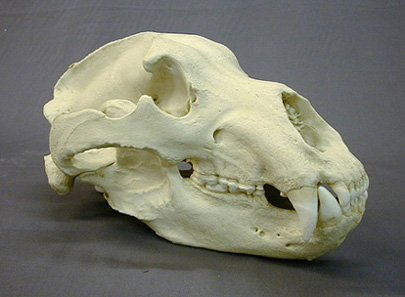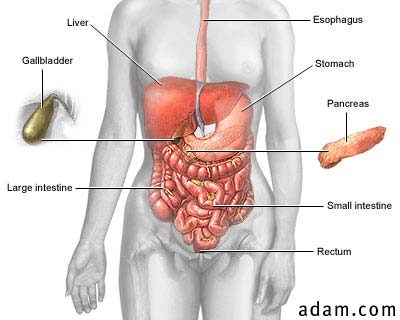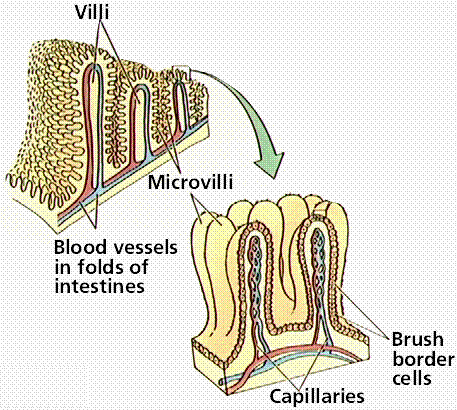
The
Digestive System
 |
The digestive system in animals has evolved in an effort to provide the
means to access nutrients from the surrounding environment. This
includes
devices to capture or collect nutrients/particles/matter/prey from the
outside world, the tools to mechanically and chemically digest these
nutrients
into smaller particles/molecules. These nutrients can now be absorbed
so
they ultimately can be distributed to the numerous cells that make up
the
organism. There is often a mechanism to eliminate any matter that is
not
digestable. |
Review
Questions:
-
What is the overall
physiological
problem that is resolved by the digestive system in animals?
-
Outline the fundamental
process
of the digestive system.
-
Nutrients and energy
move through
different levels in the ecosystem via producers and consumers. Define
producers
and consumers as well as their roles in ecosystems.
-
Distinguish between
autotrophs
and heterotrophs.
-
Distinguish between
herbivores,
omnivores and carnivores.
-
Briefly outline the
evolution
of the digestive tract in animals by using several examples from class.
-
Animals can be
categorized by
the method used to capture food. Describe four major methods. Give
examples
of animals in each category.
-
Outline the anatomy of
the digestive
tract as exemplified by the human species.
-
Do the same for the
digestive
process in a human.
-
Many animals initiate
the digestive
process with a mechanical breakdown. This can occur in the mouth region
or further down in the digestive tract depending on the animal. Briefly
explain the process and its purpose.
-
Mammals have a variety
of teeth
to accommodate the task of mechanical breakdown. Briefly describe the
variety
of teeth and their function in mammals.
-
Do all vertebrates use
their teeth
to accomplish mechanical breakdown of their food items? Use reptiles as
an examples to illustrate differences between them and the mammals.
-
What is the function of
the tongue
in the digestive system?
-
How is chemical
breakdown different
from mechanical breakdown?
-
Explain the process of
peristalsis.
-
Describe the structure
of the
human stomach.
-
Why are there muscular
sphincters
present between the stomach and the esophagus (cardiac sphincter) and
between
the stomach and the duodenum (pyloric sphincter)? What is their purpose?
-
What is the function of
the stomach?
-
Describe the chemical
environment
of the stomach. Are any enzymes released from this organ to participate
in chemical digestion?
-
What is chyme?
-
How do the stomachs
of a ruminant differ from the
human system?
-
How do ruminants
accomplish the
difficult process of digesting cellulose? Is the process evolutionarily
and ecologically important?
-
The size and length of
the small
intestine varies greatly between different mammals. Briefly explain
this
observation.
-
What is the function of
the small
intestine?
-
What is the function of
bile?
Where is bile produced? Where is it stored?
-
What is the role of the
pancreas
in the digestive process?
-
The small intestine is a
highly
vascularized organ. Explain.
-
The small intestine has
a very
high surface area relative to its size. Explain how this is
accomplished
from an anatomical perspective.
-
How do the three major
macromolecules
differ from each other in terms of their breakdown and absorption
(carbohydrates,
proteins and lipids)?
-
What is the role of the
appendix?
The cecum?
-
Does the cecum vary in
function
between different animals? Explain.
-
What is the function of
the large
intestine?
-
What is the purpose of
elimination?
How is elimination controlled?
-
Summarize: What is the
overall
physiological problem that is resolved by the digestive system in
animals?
-
Summarize: Briefly
describe the
digestive process by focusing on the following steps - a. ingestion, b.
digestion, c. absorption and d. elimination.
Films:
Links:
Lecture
Outline:
Omnivores
Herbivores
Carnivores
Suspension
Feeders
Substrate
Feeders
Fluid
Feeders
Bulk
Feeders
Overview
1.
Ingestion
2.
Digestion
Mechanical
Chemical
3.
Absorption
4.
Elimination

Compartments
Lower
animals
Mouth
Gastrovascular
cavity
Alimentary
canal
Pharynx
Esophagus
Crop
Gizzard
(stomach)
Anus
Comparing
animals
The
"Journey"
The
Human System
Oral
Cavity

Teeth
(mechanical)
Saliva
(chemical)
amylase
Tongue
(mechanical/ sensory)
Bolus
Swallowing
Esophagus
Peristalsis
as a phenomenon
Role
of the cardiac sphincter
Stomach
Structure
(muscular/ surface A)
Gastric
glands (HCl [pH 2], mucus)
Pepsinogen
(digest proteins)
Acidic
chyme
Ulcers
(link to Helicobacter pylori)
Pyloric
sphincter

The
Small Intestine
Duodenum
- Link to
Gall
bladder (bile)
Emulsifies fats (no enzymatic action)
Pancreas
(alkaline; enzymes)
Mucus;
Enzymes
Structure
Folds;
villi; microvilli
Enormous
surface area
Villi
and circulation
Absorption
of nutrients and water
Carbohydrates
Proteins
Lipids
Routes of transport
The
Large Intestine
Cecum
(role in herbivores)
Compare
herbivores and carnivores
Ruminant
animals (e.g. cows)
Appendix
Absorption
of water
Feces
Role
of bacteria in the colon
Rectum
Role
of infections (diarrhea)
Defecation
Nutrition
Food
pyramid
Macro-
and microminerals
Organic
compunds (building blocks from macromolecules)
Essential
amino acids
Essential
fatty acids
Protein
deficiency
Energy
calories as a measurement of intake
Daily
intake levels
Vitamins
fat soluble (A,D, E, K)
water soluble (B, C)







